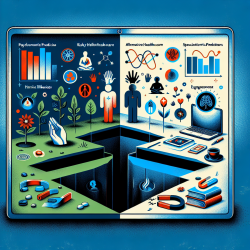As a practitioner in the field of online therapy, understanding the factors that influence engagement in risk-associated alternative healthcare (RAAH) behaviors can significantly enhance your practice. A recent study titled Demographic and psychometric predictors associated with engagement in risk-associated alternative healthcare behaviours provides valuable insights that can be directly applied to improve your therapeutic approach.
This comprehensive study explored the characteristics of adult RAAH users and the effectiveness of established psychometric instruments in predicting RAAH behaviors. The key findings indicate that RAAH engagement is influenced by several demographic factors, including gender, age, income, education, employment, chronic illness status, and ethnicity.
Key Demographic Predictors
- Gender: Women and individuals who do not identify as men or women are more likely to engage in RAAH activities compared to men.
- Age: Older respondents (55 years and above) are less likely to engage in RAAH activities, possibly due to increased risk aversion with age.
- Income: Higher income levels are associated with a greater number of RAAH behaviors, particularly in physical manipulative and herbal/nutritional categories.
- Education: Higher education levels correlate with increased engagement in RAAH activities.
- Chronic Illness: Individuals with chronic illnesses are more likely to engage in RAAH activities, seeking alternatives to conventional treatments.
- Ethnicity: Asian respondents are less likely to engage in RAAH activities compared to Caucasians.
Psychometric Predictors
The study utilized five psychometric tools to predict RAAH engagement:
- Control Beliefs Inventory (CBI): Associated with engagement in physical manipulative RAAH activities.
- Reward Responsiveness Behavioral Activation System (RBAS) Scale: Predictive of engagement in herbal/nutritional RAAH activities.
- Positive Attitudes to Science (PAS) Scale: Individuals with higher PAS scores are less likely to engage in RAAH activities.
- Satisfaction with Orthodox Medicine (SOM) Scale: Predictive of engagement in physical manipulative RAAH activities.
- Susceptibility to Persuasion-II (StP-II-B) Scale: Highly predictive of overall RAAH engagement, particularly among those with higher risk tolerance and susceptibility to advertising.
Practical Applications
As a practitioner, you can leverage these findings to better understand and address the needs of your clients who may be inclined towards RAAH behaviors. Here are some actionable steps:
- Assess Demographics: Be mindful of the demographic factors that may predispose clients to RAAH engagement.
- Utilize Psychometric Tools: Incorporate the use of psychometric tools like the StP-II-B and PAS scales to assess clients' risk tolerance and attitudes towards science.
- Educational Interventions: Develop educational interventions to inform clients about the risks associated with certain RAAH behaviors.
- Open Communication: Encourage open communication with clients about their use of alternative therapies and provide evidence-based guidance.
Understanding these predictors can help you tailor your therapeutic approach to better meet the needs of your clients, ultimately improving their overall well-being.
To read the original research paper, please follow this link: Demographic and psychometric predictors associated with engagement in risk-associated alternative healthcare behaviours.










